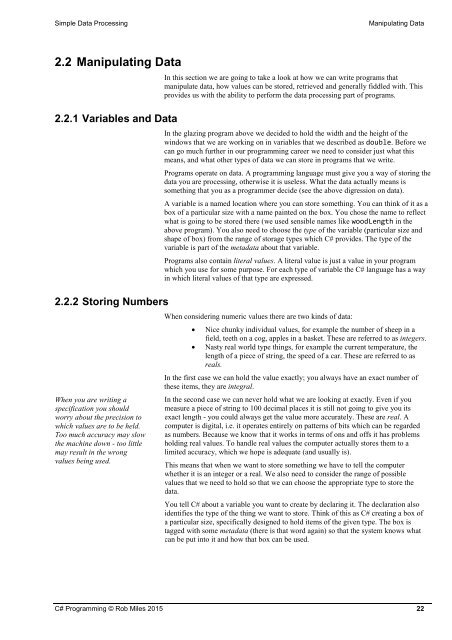C Programming Yellow Book
6019BjHWX
6019BjHWX
Create successful ePaper yourself
Turn your PDF publications into a flip-book with our unique Google optimized e-Paper software.
Simple Data Processing<br />
Manipulating Data<br />
2.2 Manipulating Data<br />
2.2.1 Variables and Data<br />
2.2.2 Storing Numbers<br />
When you are writing a<br />
specification you should<br />
worry about the precision to<br />
which values are to be held.<br />
Too much accuracy may slow<br />
the machine down - too little<br />
may result in the wrong<br />
values being used.<br />
In this section we are going to take a look at how we can write programs that<br />
manipulate data, how values can be stored, retrieved and generally fiddled with. This<br />
provides us with the ability to perform the data processing part of programs.<br />
In the glazing program above we decided to hold the width and the height of the<br />
windows that we are working on in variables that we described as double. Before we<br />
can go much further in our programming career we need to consider just what this<br />
means, and what other types of data we can store in programs that we write.<br />
Programs operate on data. A programming language must give you a way of storing the<br />
data you are processing, otherwise it is useless. What the data actually means is<br />
something that you as a programmer decide (see the above digression on data).<br />
A variable is a named location where you can store something. You can think of it as a<br />
box of a particular size with a name painted on the box. You chose the name to reflect<br />
what is going to be stored there (we used sensible names like woodLength in the<br />
above program). You also need to choose the type of the variable (particular size and<br />
shape of box) from the range of storage types which C# provides. The type of the<br />
variable is part of the metadata about that variable.<br />
Programs also contain literal values. A literal value is just a value in your program<br />
which you use for some purpose. For each type of variable the C# language has a way<br />
in which literal values of that type are expressed.<br />
When considering numeric values there are two kinds of data:<br />
• Nice chunky individual values, for example the number of sheep in a<br />
field, teeth on a cog, apples in a basket. These are referred to as integers.<br />
• Nasty real world type things, for example the current temperature, the<br />
length of a piece of string, the speed of a car. These are referred to as<br />
reals.<br />
In the first case we can hold the value exactly; you always have an exact number of<br />
these items, they are integral.<br />
In the second case we can never hold what we are looking at exactly. Even if you<br />
measure a piece of string to 100 decimal places it is still not going to give you its<br />
exact length - you could always get the value more accurately. These are real. A<br />
computer is digital, i.e. it operates entirely on patterns of bits which can be regarded<br />
as numbers. Because we know that it works in terms of ons and offs it has problems<br />
holding real values. To handle real values the computer actually stores them to a<br />
limited accuracy, which we hope is adequate (and usually is).<br />
This means that when we want to store something we have to tell the computer<br />
whether it is an integer or a real. We also need to consider the range of possible<br />
values that we need to hold so that we can choose the appropriate type to store the<br />
data.<br />
You tell C# about a variable you want to create by declaring it. The declaration also<br />
identifies the type of the thing we want to store. Think of this as C# creating a box of<br />
a particular size, specifically designed to hold items of the given type. The box is<br />
tagged with some metadata (there is that word again) so that the system knows what<br />
can be put into it and how that box can be used.<br />
C# <strong>Programming</strong> © Rob Miles 2015 22


